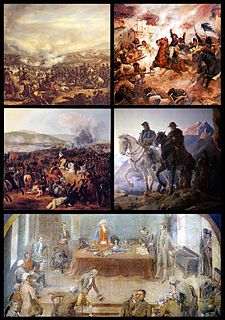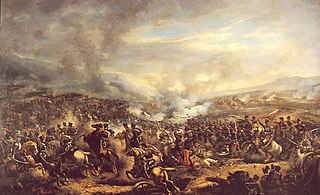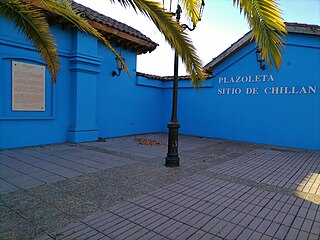The Attack
At 0700 on 3 March, Elorreaga sent an ultimatum to Spano to surrender Talca within fifteen minutes, or face destruction. Spano concluded he might be able to hold out long enough for Bascuñán's force to return and defend the town; sending an urgent message to Bascuñán, he arrayed all his forces, including his three artillery pieces, to defend the location. Elorreaga, knowing he had to take the town before Patriot reinforcements arrived, launched a ferocious attack.
The fighting went on all morning, but by noon the Royalist forces had managed to take and position themselves on the roof of the house of Vicente de la Cruz Bahamondes; a substantial and well positioned building, this enabled them to dominate the town. With this, the battle became a massacre. Spano was killed in the fighting and by the time Bascuñán arrived, the Royalists were in control of Talca.

Bernardo O'Higgins Riquelme was a Chilean independence leader who freed Chile from Spanish rule in the Chilean War of Independence. He was a wealthy landowner of Spanish and Irish ancestry. Although he was the second Supreme Director of Chile (1817–1823), he is considered one of Chile's founding fathers, as he was the first holder of this title to head a fully independent Chilean state.

The Argentine War of Independence was fought from 1810 to 1818 by Argentine patriotic forces under Manuel Belgrano, Juan José Castelli and José de San Martín against royalist forces loyal to the Spanish crown. On July 9, 1816, an assembly met in San Miguel de Tucumán, declared full independence with provisions for a national constitution.

The First Battle of Newbury was a battle of the First English Civil War that was fought on 20 September 1643 between a Royalist army, under the personal command of King Charles, and a Parliamentarian force led by the Earl of Essex. Following a year of Royalist successes in which they took Banbury, Oxford and Reading without conflict before storming Bristol, the Parliamentarians were left without an effective army in the field. When Charles laid siege to Gloucester, Parliament was forced to muster a force under Essex with which to beat Charles' forces off. After a long march, Essex surprised the Royalists and forced them away from Gloucester before beginning a retreat to London. Charles rallied his forces and pursued Essex, overtaking the Parliamentarian army at Newbury and forcing them to march past the Royalist force to continue their retreat.

The Battle of Maipú was a battle fought near Santiago, Chile on April 5, 1818 between South American rebels and Spanish royalists, during the Chilean War of Independence. The Patriot rebels led by Argentine general José de San Martín effectively destroyed the Spanish forces commanded by General Mariano Osorio, and completed the independence of the core area of Chile from Spanish domination.

The Battle of Chacabuco, fought during the Chilean War of Independence, occurred on February 12, 1817. The Army of the Andes of the United Provinces of the Río de la Plata led by General Captain José de San Martín defeated the Spanish force led by Rafael Maroto. It was a defeat for the Captaincy General of Chile, the royalist government established after the division of the Viceroyalty of Peru.

The Battle of Cancha Rayada, was fought in Chile between South American patriots and Spanish royalists, during the Osorio's campaign in the South American wars of independence. The result was a defeat for the patriot forces, weeks later the patriots take their rematch at the Battle of Maipú.

The Chilean War of Independence was a war between pro-independence Chilean criollos seeking political and economic independence from Spain and royalist creoles supporting continued allegiance to the Captaincy General of Chile and membership of the Spanish Empire.

The Battle of Huamachuco was fought on the 10 July 1883, and it was the last major battle of the War of the Pacific. The Chilean soldiers led by Colonel Alejandro Gorostiaga decisively defeated the Peruvian army commanded by General Andrés Avelino Cáceres near the town of Huamachuco. This Chilean victory effectively eliminated Cáceres' Ejército de la Breña, ending any real threat or resistance in the Peruvian Andes. The Peruvian defeat paved the way for the Treaty of Ancon that finally put an end to the war. Also, one of Peru's greatest heroes, Colonel Leoncio Prado, died as a consequence of this battle.

Gabino or Gavino Gaínza y Fernández de Medrano was a Spanish military officer and politician in Spain's American colonies. During the Latin American wars of independence, he initially fought on the royalist side, in Chile. Later, in Guatemala, he supported independence and became the first president of a united Central America extending from Soconusco through Guatemala, El Salvador, Honduras, Nicaragua and Costa Rica.
Treaty of Lircay was a truce treaty agreed between the Royalist and the Patriot forces during the Chilean War of Independence.

Events from the year 1814 in Chile
The Battle of Les Tres Acequias, fought during the Chilean War of Independence, occurred near San Bernardo on 26 August 1814. The confrontation occurred between the two factions of Carrera and Bernardo O'Higgins, resulting in a defeat for O'Higgins that would in turn lead on to the defeat of the nationalists by the royalist forces at the battle of Rancagua a month later.

The Battle of El Roble was fought on the Itata river, 17 October 1813, between the Chilean patriot general José Miguel Carrera and Spanish royalist forces under the command of Clemente Lantaño and de Luis Urrejola. The surprise patriot victory at El Roble as a result of Bernardo O'Higgins' actions at the end of the day was to result in a change of patriot commander, and a severe split within the patriot movement.

The Siege of Chillán occurred July 27 to August 10, 1813, as patriot forces attempted to dislodge a determined band of royalist defenders. The failure of José Miguel Carrera to take the city would contribute to his removal from office by the junta later in the campaign.
The battle of Quechereguas occurred on 8 April 1814, during the War of Chilean Independence.
The battle of Membrillar occurred on 20 March 1814, during the War of Chilean Independence.
The battle of el Quilo, fought during the Chilean War of Independence, occurred at el Quilo, on the southern side of the Itata river, on 19 March, 1814.

Patria Nueva was a period in the history of Chile that began with the victory of Ejército de los Andes in the Battle of Chacabuco on 12 February 1817 and ended with the resignation of Bernardo O'Higgins as Supreme Director in 1823.
The Battle of Leeds took place during the First English Civil War on 23 January 1643, when a Parliamentarian force attacked the Royalist garrison of Leeds, Yorkshire. The attack was partly dictated by the need to maintain local support for the Parliamentarian cause; the Earl of Newcastle had recently shifted the balance of power in Yorkshire in the Royalists' favour with the addition of his 8,000-strong army, and sent one of his commanders, Sir William Savile to capture Leeds. The West Riding of Yorkshire relied on the cloth trade, and Ferdinando, Lord Fairfax sent his son, Sir Thomas Fairfax to bolster the defences of nearby Bradford, before agreeing to his request to attack Leeds.
The Battle of Tadcaster took place during the First English Civil War on 7 December 1642, when a Royalist force attacked the Parliamentarian garrison of Tadcaster, Yorkshire, which was held by between 900 and 1,500 soldiers under the command of Ferdinando Fairfax, Lord Fairfax. Newcastle marched out of York on 6 December, and split his force of 6,000 into two; he took 4,000 infantry down the main York–Tadcaster road to attack the town from the east, while sending a deputy, the Earl of Newport, with a further 1,500 to circle around and trap the Parliamentarians by attacking from the north-west.












